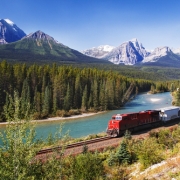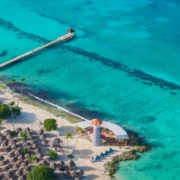Nestled in the heart of North America, the Canadian Rockies are the epitome of jaw-dropping grace and beauty, demonstrating nature’s grandeur. This stretch of the Rockies attracts millions of tourists each year, enticing visitors with promises of breathtaking views, exciting activities, and glimpses of diverse wildlife.
So, where are the Canadian Rockies, and when is the best time to visit this vast mountain range? These mountains stretch from Montana into British Columbia, and the best time to visit depends on what you want to do while you’re there. Let’s explore the best seasons to visit based on the experiences you’re pursuing.
Understanding the Seasons in the Canadian Rockies
The Canadian Rockies experience four distinct seasons, each contributing to the region’s unique charm. When spring rolls around, the landscape begins to awaken from winter slumber, slowly morphing from a frozen mass to give way to soft, delicate sprouts.
As spring fades into summer, the landscape becomes awash in a panorama of vibrant hues, transforming it through a blend of bright flowers and deep green grasses. The slopes are coated in captivating wildflowers, from Prairie Crocuses to Early Blue Violets.
When summer gives way to fall, the colors transform from bright pinks, purples, yellows, and greens to a canvas of golden hues. The trees boast an assortment of colors, from warm golds to russet reds, dropping leaves as the season progresses to bathe the ground in vibrant hues.
When winter’s tendrils eliminate the final hints of fall, the mountains become an awe-inspiring winter wonderland. The peaks are blanketed in snow, lakes turning to frozen rinks.

When is the Best Time to Visit the Canadian Rockies?
Each season presents its fair share of opportunities, particularly for outdoor adventurers. The best time to go hinges on what you want to do! If you plan to visit for the outdoor activities, you’ll plan your trip around those activities, but if you want to visit for indoor adventures, it’s up to you!
Best Times to Visit for Outdoor Activities
To make the most of your outdoor adventures in the Canadian Rockies, it’s essential to choose the right time to go based on your preferred activity. If you love hiking, camping, rafting, and kayaking, late spring and early summer are the perfect times to visit. The temperatures are ideal, the landscape comes alive with vibrant vegetation, and wildlife is active, so it’s an excellent time to visit.
If you prefer peaceful hikes teeming with autumn foliage and fewer visitors, fall is an excellent time to go. However, be sure to prepare accordingly, as temperatures begin to drop significantly at night.
Winter presents its own set of adventures, creating the perfect conditions for snow sports. From snowboarding and skiing to ice climbing and skating, there’s plenty to do. It can get packed with out-of-town visitors during this time of year, especially around the holiday season, so plan your trip and book in advance.
Best Times to Visit for Indoor Activities
If you prefer the comfort of indoor activities, the towns speckled throughout the Canadian Rockies have much to offer. From museums and galleries boasting rich historical pieces and beautiful art to spas and pools with hot springs, there’s plenty to do.
If you want to stick mostly to indoor activities, plan your trip around towns home to your must-do activities. Of course, you can pop around the towns, but if you visit in the winter, travel can be difficult, so it might be easiest to pick a single town.
Travel Considerations: On and Off Seasons
The Canadian Rockies attract visitors year-round, drawing in adventurers seeking everything from snow sports to summer hikes. However, activity often peaks during the summer and winter, as the weather is perfect for an assortment of activities.
So, if you want to visit during an “off” season, visit during the early spring or mid to late fall. By this time, the surge has usually tapered off, with more openings for accommodation and activities.
Of course, it’s important to note that accommodations and activities often fill up quickly, even during slower seasons. Due to the demand, it’s important to plan your trip in advance to ensure you get a place to stay and can complete your must-do adventures.

Experience the Beauty of the Canadian Rockies With Caravan
Picking the ideal season to visit is an integral part of making the most out of your trip to the Canadian Rockies. While summer and winter often attract the highest number of visitors, the off seasons are still excellent times to visit. If you’re ready to explore the wonders of the Canadian Rockies but don’t want to worry about these details, a guided tour might be the solution.
At Caravan, we offer Canadian Rockies tours that stretch for nine days, taking visitors to the best spots, including a stop at Glacier Park. From the bright blue waters of Lake Louise to the “Going to the Sun” Road up Logan Pass, this adventure checks off the must-dos and must-sees during your visit. Ready to book a trip? Call 1-800-CARAVAN or 1-312-321-9800 to get started!


















